Making Cat Food at Home: A Comprehensive Guide
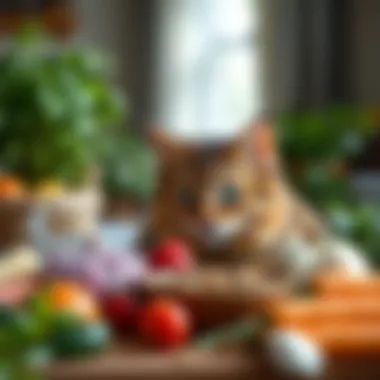
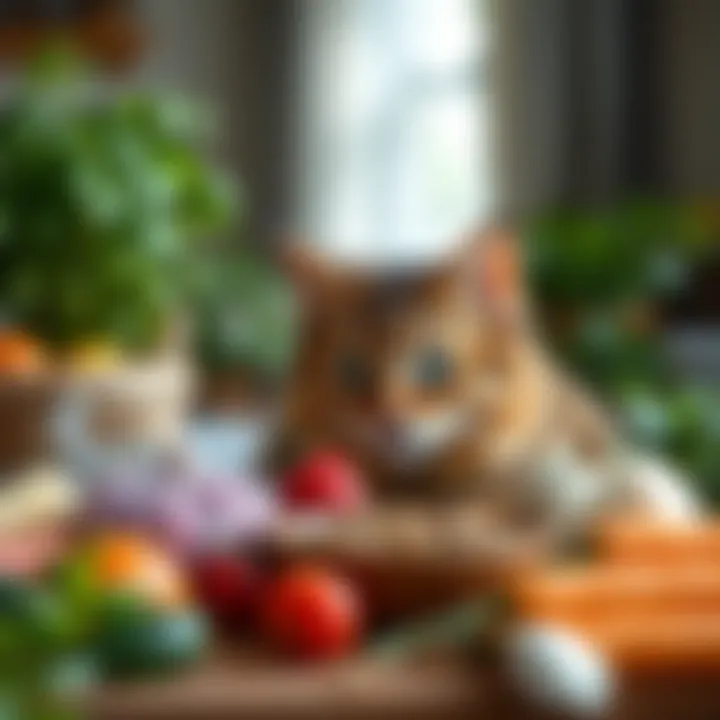
Intro
Creating a nutritious diet for a cat can feel like walking a tightrope at times. Owners often grapple with the question of what to feed their feline companions, and convenience sometimes overshadows nutrition. But making cat food at home can be a rewarding alternative. It allows pet owners to control the ingredients, ensuring that every morsel is as healthy as can be. This guide aims to help you navigate the process from selecting the right ingredients to preparing meals safely and effectively.
Pet Care Essentials
Caring for a cat is more than just a matter of filling their bowl with food. A complete and balanced diet is essential for their day-to-day well-being. It’s important to consider various factors that contribute to a cat's overall health. Here’s a closer look at some crucial aspects of pet care:
Daily Nutrition Requirements
Each cat has unique nutritional needs, influenced by their age, weight, activity level, and health condition. For adult cats, a diet comprising about 50-60% protein and limited carbohydrates is generally recommended. Home-prepared meals should ideally feature an array of ingredients like meat, fish, some vegetables, and supplements when needed. An ideal balance keeps your cat agile and lively, similar to a well-oiled machine.
Exercise and Playtime
Nutrition wouldn't mean much if it isn't balanced with activity. Cats need ample playtime and exercise to maintain a healthy weight and mental sharpness. Interactive toys or simple laser pointers can help keep your feline friend entertained. Building regular play sessions into the day is akin to oiling the gears of a watch—it's essential for smooth functioning!
Grooming Tips
Believe it or not, grooming goes hand-in-hand with diet. Regular brushing helps reduce shedding and the formation of hairballs, a common issue for many cats. Depending on your cat's coat type, grooming might need to happen daily or weekly. Be sure to choose brushes that match your cat's fur length and thickness. Cats, especially long-haired ones, appreciate regular grooming as it helps in managing their fur while strengthening the bond you share.
Health and Wellness Check-ins
Routine veterinary check-ups are a cornerstone of proper cat care. Regular check-ups can catch potential health issues before they escalate. Keeping records on your cat's weight and behavior changes can paint a clearer picture for your veterinarian, helping in diagnostics just like piecing together a puzzle. It’s also a good practice to be alert for any changes in appetite or energy levels, which could signal underlying problems.
"A well-fed cat is a happy cat, but a healthy cat relies on much more than just food."
Understanding these pet care essentials paves the way for making informed decisions about home-cooked meals for your feline friend. The journey of crafting cat food at home is not solely about sustenance; it's about enhancing your cat's quality of life in myriad ways.
Understanding Feline Nutrition
Understanding feline nutrition is not just a lesson in what to put in your cat's bowl; it’s a path to a healthier, happier pet. What you feed your cat plays a monumental role in its overall wellbeing. In this segment, we will unpack the fundamental elements that make up a balanced diet for cats, the benefits of crafting home-cooked meals, and some key considerations that every cat owner should take to heart when it comes to feeding time.
A cat's diet is specifically designed by nature, as cats are obligate carnivores. This means that their bodies require a diet primarily made up of meat. However, knowing what meat and how much of it along with other components they need can be a real head-scratcher for many pet owners.
By exploring the ins and outs of feline nutrition, cat owners can gain a comprehensive understanding of their pets’ needs. They can navigate the aisles of the grocery store or farmer's market like a pro when it comes to selecting quality ingredients. This knowledge arms pet owners against misleading information and helps to ensure that their furry friends thrive.
Essential Nutrients for Cats
Every cat deserves the best kind of nourishment, and that starts with understanding the essential nutrients they need.
Proteins
Proteins are the building blocks of life, particularly for our feline friends. Cats require a higher protein intake than many other pets. It’s crucial for their growth and overall health. The very essence of their muscle development, enzyme function, and tissue repair relies heavily on protein. Sources such as chicken, beef, and fish are not only beneficial but also appeal to most cats’ palates.
One key aspect of protein is its role in energy production. Unlike human dietary needs where a balance of proteins, fats, and carbohydrates is ideal, cats thrive on higher protein levels to maintain energy. Moreover, not all proteins are created equal; animal-based proteins contain the essential amino acids that cats need, such as arginine and methionine, making them a top choice for this article.
Fats
Fats often get a bad rap, but in the case of feline nutrition, healthy fats are indispensable. Omega-3 and -6 fatty acids play a role in skin health and coat quality, which are visible indicators of your cat’s wellbeing. These are found in fish oils and certain seeds.
What sets fats apart is their role as a concentrated energy source. They help your cat absorb fat-soluble vitamins and also play an integral part in maintaining their cell structure. Still, moderation is key. Too much fat can lead to obesity, which is no friend to a cat’s overall health.
Carbohydrates
Carbohydrates are a bit of a grey area in feline diets. While cats can digest some carbs, they do not require them in the same quantities as humans or dogs. Cats primarily obtain their energy from proteins and fats; however, including a small amount of carbohydrates from safe vegetables or rice can provide some benefits, such as fiber for digestive health.
It’s vital to choose sources that are easily digestible. Too many complex carbohydrates can lead to stomach issues and even obesity over time.
Vitamins & Minerals
Vitamins and minerals may not be the star players, but they are the unsung heroes that keep everything running smoothly. Essential for numerous bodily functions including metabolism, immunity, and overall cell function, these micronutrients are often overlooked.
Certain vitamins like A, E, and certain B vitamins are essential for healthy vision, skin, and energy. Incorporating a variety of vegetables and the right multivitamins can lead you down the right path in achieving optimum cat health.
Common Dietary Deficiencies
Many cat owners unknowingly put their furry friends at risk of dietary deficiencies. These shortfalls can lead to health issues that are often preventable with proper understanding.
Importance of Taurine
Taurine is a sulfur-containing amino acid that is non-negotiable in a cat’s diet. Cats cannot synthesize taurine efficiently, so it is critical they get it from their food. A deficiency in taurine can lead to serious health consequences, such as heart disease and vision problems. For those venturing into homemade diets, ensuring adequate taurine in their recipes is vital to safeguarding their cat's health.
Risk of Imbalanced Diets
Creating a balanced diet can be more challenging than it seems. Many first-time cat food makers tend to not get the ratio right. An imbalanced diet can lead to serious health ramifications ranging from obesity to malnutrition. Cats require a specific ratio of proteins, fats, vitamins, and minerals. If any of these are lacking or in excess, it could throw a wrench in their health plan. Understanding these risks empowers cat owners to create meals that support longevity and vitality.
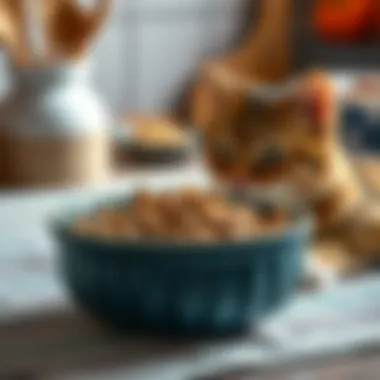
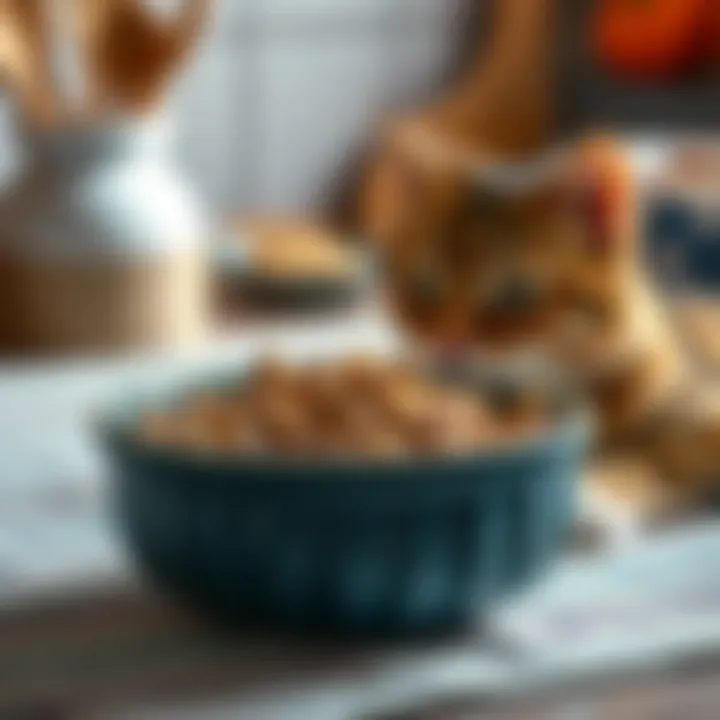
"The health of your cat starts with the food in its bowl. Knowledge is the first step toward wellness."
Benefits of Homemade Cat Food
When delving into the concept of creating cat food at home, the benefits stand out vividly. By opting for homemade cat food, pet owners can foster a deep connection with their feline companions while also addressing their individual needs. The significance of these benefits extends beyond mere preference—it's about ensuring health, satisfaction, and overall well-being.
Quality Control
Selecting Fresh Ingredients
Selecting fresh ingredients is paramount when it comes to whipping up meals for your cat. Freshness can significantly enhance nutritional value, thus directly contributing to your pet’s health. When you pick ingredients straight from your local market, you can rest easy knowing there are no hidden additives or preservatives.
The key characteristic of selecting fresh ingredients is that they often provide a more robust flavor. Cats can be quite finicky, and a meal that smells and tastes good can make all the difference. Unlike commercial brands, which may use less desirable parts, homemade food gives you the reins.
One unique feature of this practice is that you have the power to select organic options over conventional ones. Organic ingredients often come with fewer pesticides and chemicals, which translates to a healthier choice. The downside is that organic options can come with a higher price tag, but many would argue it's worth it considering the potential health benefits for your cat.
Avoiding Contaminants
Avoiding contaminants is another vital aspect of making cat food at home. The food industry has long faced issues with recalls and contamination. By preparing your cat's meals, you can steer clear of the risk associated with commercial food mishaps. You have the chance to choose where the ingredients come from, ensuring they are free from harmful substances.
The appeal here lies in the control you gain. You’ll know exactly what's in your cat's food and can make informed choices about which ingredients to include. A distinct feature of this approach is your ability to avoid any allergens that may be present in store-bought options. However, it requires diligence and research to ensure that you are adept at spotting potential contaminants yourself, which could take some time for new pet owners.
Customization for Allergies and Preferences
Identifying Food Sensitivities
Identifying food sensitivities is crucial for many cats, as some may endure allergies that can lead to serious health issues. When you prepare meals at home, you gain the insight to observe how your cat reacts to various ingredients. This means you can quickly eliminate anything that doesn’t sit well with your furry friend.
The primary advantage of this meticulous observation is that you can create a specialized diet tailored uniquely for your cat. This is particularly beneficial for older cats or those with existing health conditions. The challenge lies in the initial trial-and-error period, which can require patience and careful note-taking to figure out what works best.
Tailoring Recipes to Preferences
Tailoring recipes to a cat’s preferences ensures that mealtime is a moment of joy, rather than a chore. Each cat has its own taste and texture favorites, and by cooking at home, you can hone in on those preferences. Maybe your cat gobbles up chicken but turns its nose up at fish—now you have the flexibility to cater to that.
This personalization not only helps in providing a satisfying meal but can also reflect positively on their eating habits, thus encouraging a healthier lifestyle. A unique benefit here is the ability to experiment without being locked into a specific commercial formula. However, this flexibility might lead to challenges if you accidentally create a recipe that your cat simply despises, which can cause a little food waste in your initial trials.
To sum it up, embracing the practice of homemade cat food delivers numerous benefits. From establishing quality control to honing in on dietary needs and preferences, this path empowers pet owners to truly care for their feline friends. It’s an adventure accompanied by careful consideration, but with rewards that certainly outweigh the efforts.
Ingredient Selection
Choosing the right ingredients is at the heart of creating nutritious homemade cat food. This consideration is not simply about what looks good on paper, but about how these components work in harmony to support feline health. The right selection ensures that your cat gets the full spectrum of nutrients, while also allowing you the flexibility to accommodate any specific dietary needs your feline friend might have.
The source and quality of the ingredients can heavily influence the health benefits a meal provides, particularly for cats, who are obligate carnivores. Each ingredient you select boasts unique attributes that contribute to the overall diet's quality. Hence, understanding what to include, and what to steer clear of, can make all the difference in ensuring your pets thrive on their homemade meals.
Meat Sources
Types of Acceptable Meats
When it comes to meats, not all are created equal. Some of the prime contenders include chicken, beef, lamb, and turkey. Each of these types brings a set of benefits that cater well to a cat's nutritional needs. For instance, chicken is a popular choice; it's widely accepted, palatable for most cats, and rich in proteins essential for their muscle development and overall energy.
The unique feature of chicken lies in its high palatability, ensuring that even picky eaters are more likely to indulge. Furthermore, turkey and lamb can provide much-needed variety, preventing mealtime fatigue. However, one must be cautious, as certain meat types may contain additives or come from less reputable sources, which could affect your cat's health.
Organic vs Conventional Options
This brings us to the debate between organic and conventional options. Organic meats can be a beneficial choice as they are generally free from hormones and antibiotics that can sometimes be found in conventional types. This lack of chemicals means less risk of adverse reactions in your pet.
On the other hand, organic meats can carry a heftier price tag, which might push some people toward the conventional option. However, if quality matters to you, then investing in organic sources could pay off in terms of your cat's health and happiness. So, weighing the pros and cons is essential when making this decision.
Vegetable and Grain Choices
Safe Vegetables for Cats
Including vegetables in your cat's diet can enhance the nutritional profile of their meals. Certain vegetables, such as carrots, peas, and squash, can add vitamins and fiber to their meals. The key characteristic of these vegetables is that they are non-toxic and can contribute to better digestion, which can be particularly helpful for older cats.
However, not all vegetables are safe. For instance, onions and garlic can be detrimental to a cat's health and should be avoided at all costs. Choosing safe vegetables not only contributes to a wholesome diet but also diversifies the flavors and textures.
Grains: Necessity or Avoidance
Grains often spark debates among pet owners. While cats typically don’t need carbohydrates as a mainstay in their diet, certain grains might still be acceptable in small doses. Foods such as rice or oats can serve as fillers and can offer some energy. Their key advantage is that they can help create a more filling meal, which is sometimes essential for a cat’s overall wellbeing.
However, it's critical to monitor how your cat reacts to grains. Some cats may be more prone to digestive complications from grains, and in these cases, avoiding them might be the best course of action to maintain your pet's health.
Supplements and Additives
Necessary Supplements
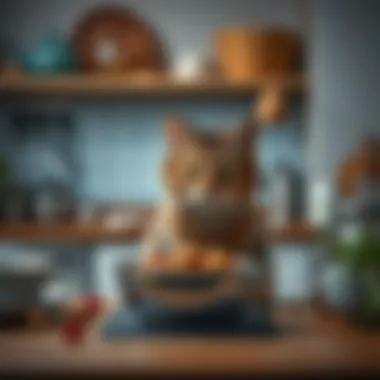
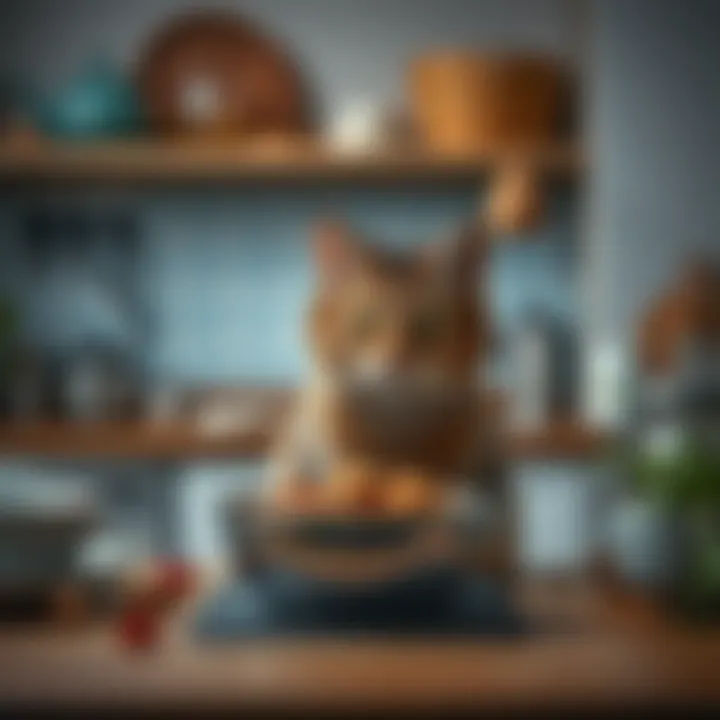
Supplements can often fill gaps that normal diets leave unaddressed. Omega fatty acids, for instance, can contribute to a shiny coat and good skin health. Including necessary supplements will ensure that your cat receives comprehensive nutrition that supports various body processes and promotes longevity.
That said, not all supplements are created equal. Consulting with a vet before adding them to your cat's meals is a smart approach to ensure that you’re making choices that are backed by logic and expertise.
Probiotics and Enzymes
Lastly, probiotics and enzymes can play a vital role in maintaining a healthy gut environment for your cat. Probiotics help stabilize the intestinal flora, which can be quite beneficial for digestion. Enzymes, on the other hand, assist in breaking down food material and can help enhance nutrient absorption.
The key feature of these additions is that they support the digestive health of your cat, which can be a crucial aspect of a homemade diet. However, it's important to introduce them cautiously and to monitor any changes in your cat’s health or behavior after incorporating these supplements.
Remember: Always consult a veterinarian before making any significant changes to your cat’s diet.
Recipes for Homemade Cat Food
Creating homemade cat food opens the door to a world of nutrition carefully tailored to meet your feline companion's needs. This section of the guide dives into the recipes that form the backbone of a well-balanced homemade diet. Crafting these meals at home not only ensures quality ingredients but also allows for adjustments based on your cat’s individual tastes and preferences. Moreover, home-cooked meals often stand as a healthier alternative than some commercial cat foods packed with fillers and preservatives, making it an initiative worth pursuing.
Cooked Diet Recipes
Chicken and Rice Recipe
The Chicken and Rice recipe holds a special place in the hearts of many pet owners. It's simple yet effective, combining two widely accepted ingredients that provide essential proteins and carbohydrates. The cooked chicken serves as a primary protein source that assists in muscle development, while rice offers a digestible energy component. What makes this recipe particularly appealing is its ease of preparation, allowing even novice cooks to whip it up without breaking a sweat.
One of its key traits is versatility; variations can be made by adjusting the seasoning or by adding safe vegetables like carrots or peas. However, it’s important to avoid seasonings like onion or garlic that can be detrimental to cats. The notable upside of this dish is its palatability, appealing to many finicky eaters. The downside, though, is that it may not provide all the micronutrients required over long-term feedings, thus needing discretion in terms of supplementation or rotation with other meals.
Fish Pâté Recipe
Diving into a soothing blend, the Fish Pâté recipe can be a game changer, particularly for cats who lean more towards fish-based diets. Rich in omega-3 fatty acids, this type of food contributes to a glossy coat and can aid in joint health. It's likely to please even the pickiest of diners, thanks to the delectable flavor fish brings.
A standout element of this recipe is its creamy texture, which is quite satisfying for cats. The preparation is simple: it includes cooked fish, a little water or broth, and can be easily blended to a fine consistency. However, one must tread carefully with the types of fish used; meals should include low-mercury options, such as salmon or sardines, to ensure safety. On the downside, fish-based recipes may need a careful balance to avoid excessive phosphorus and ensure complete nutrient coverage.
Raw Diet Recipes
Barf Diet Basics
The concept behind the Biologically Appropriate Raw Food (BARF) diet revolves around feeding cats what they would typically eat in the wild—raw meat, bones, and some vegetables. This approach harnesses the natural instincts of felines and aims to provide a complete nutritional profile that mirrors what their ancestors thrived on. It supports optimal health and vitality, promoting a glossy coat and healthy weight.
A defining characteristic of BARF is its composition: it combines muscle meat, organ meat, and occasionally some ground bone. This blend offers an excellent source of protein and essential fatty acids. However, the potential pitfalls include the risk of introducing harmful bacteria if proper hygiene isn't maintained during preparation. Additionally, those unfamiliar with raw feeding might find it challenging to ensure that their recipes cover the full spectrum of nutrients that cats require.
Raw Chicken Recipe
Delving deeper into the world of raw diets, the Raw Chicken Recipe serves as a prime example of simplicity and nourishment. This dish generally includes raw chicken, offering high protein content that’s easily digestible for cats. Raw chicken can provide a fabulous variety in texture and taste, while also preventing the boredom that sometimes comes with a monotonous diet.
The appeal lies in its straightforward nature, allowing for quick assembly. However, there are risks involved: ensuring the meat is fresh and sourcing from reputable suppliers to avoid foodborne pathogens is crucial. A notable downside is the need for careful oversight of the overall diet to prevent deficiencies that could arise if relying solely on one type of protein. Like the BARF diet, it requires a thorough understanding of feline nutrition to ensure a balanced meal.
Homemade cat food allows respiratory, gastrointestinal, and even emotional benefits, thus creating an enriched life experience for your feline friend.
Preparation and Storage Guidelines
When it comes to crafting cat food at home, the preparation and storage guidelines play an integral role in ensuring that your furry friend gets balanced and safe nutrition. Proper methods not only enhance the freshness of the food but also ensure that it remains free from harmful pathogens that can cause illnesses. Understanding these principles allows pet owners to provide a wholesome diet tailored to their cat's specific needs, ultimately leading to better health outcomes.
Cooking Methods
Baking, Boiling, and Steaming
One of the common methods for preparing homemade cat food includes baking, boiling, and steaming. Each method comes with its own set of advantages, contributing significantly to the nutrition and safety of the meals prepared. Baking, for instance, can generate a desirable texture and enhance flavors, making food more appealing for cats. It can be particularly effective for recipes that involve meat, allowing it to retain its moisture while becoming crispy on the outside, which many felines find irresistible.
Boiling, on the other hand, is often preferred when you want to hydrate pet food or prepare ingredients like rice or vegetables, ensuring they are soft enough for easy digestion. This method is also straightforward, as it requires merely submerging ingredients in boiling water until cooked.
Steaming has its own charm. It's a gentle method that preserves more nutrients compared to boiling, as it doesn't leech vitamins and minerals into the water. By using steam, you’re also avoiding the addition of unhealthy fats that may come from other cooking methods, ensuring what you serve is as nutritious as possible.
In summary, whether it’s the crispy delight from baking or the nutrient retention from steaming, each cooking technique has its place in the homemade cat food realm. Yet, it’s essential to be mindful of cooking times and temperatures to achieve the best results without compromising safety.
Avoiding Harmful Cooking Practices
While preparing cat food, avoiding harmful cooking practices is fundamental to ensuring the safety of the meals you create. Certain cooking utensils and methods can pose risks. For example, using non-stick cooking pans can be problematic, as some coatings may release toxic fumes if overheated. Opt for glass or stainless steel instead, as they're safer alternatives.
Another critical consideration is to avoid seasoning. Cats have different nutritional needs than humans and do not benefit from added ingredients like salt or garlic that could lead to toxicity or health issues over time. Also, be cautious about cross-contamination with raw meats. Always sanitize surfaces and tools after working with raw ingredients to avoid harmful bacteria.
These practices are not only beneficial but crucial in ensuring that the homemade meals remain a healthy choice for your cat. By establishing a clean and safe cooking environment, you significantly reduce health risks and keep your feline companion safe.
Storage Solutions for Freshness
Refrigeration Techniques
After whipping up a batch of nutritious cat food, how you store it is as vital as how you cook it. Refrigeration techniques can make a world of difference in maintaining freshness. For short-term storage, keep the food in airtight containers to prevent spoilage and odor absorption. Using glass or BPA-free plastic, you can effectively minimize the risk of chemical leeching into the food.
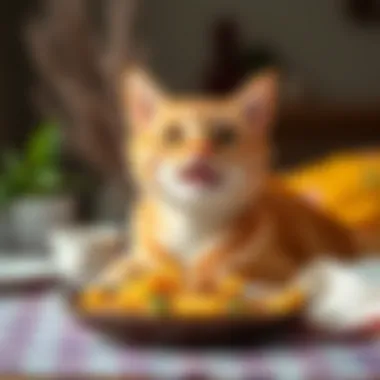
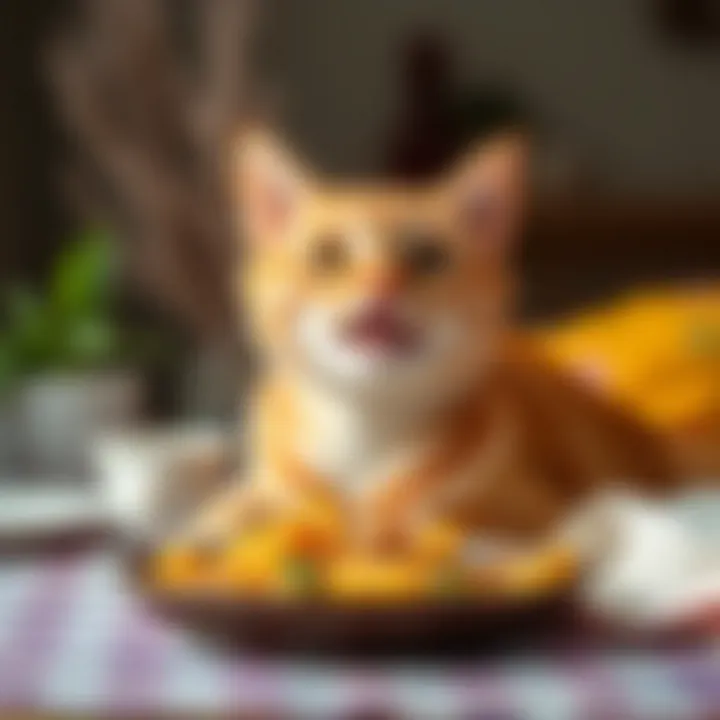
It's recommended to store the cat food in the coldest part of the refrigerator, ideally at 32°F to 40°F (0°C to 4°C), where it can last for several days. However, it's wise to label containers with the preparation date to keep track of freshness and usability.
Freezing for Longevity
Freezing for longevity is often the go-to solution for those who wish to prepare larger batches of cat food. This method can keep food safe for many months without significant nutrient loss. Before storing in the freezer, it’s best to divide meals into portions. This way, you only thaw what’s necessary, which promotes optimal freshness upon serving.
Using freezer-safe bags or containers can provide a solid barrier against freezer burn. It’s advisable to remove as much air as possible to minimize freezer burn, which can negatively affect texture and taste.
End
Health Considerations
The journey into preparing homemade cat food highlights the vital importance of health considerations. Understanding how to make food for cats goes beyond mere recipes; it requires awareness of how dietary choices affect their overall well-being. When you take charge of your cat’s nutrition, you embark on a path towards a healthier life for your feline friend.
Monitoring Your Cat's Health
Routine Vet Checkups
Routine vet checkups can’t be overstated. Scheduling regular visits to a veterinarian serves as a pivotal aspect of ensuring your cat remains in the best health. During these checkups, the vet evaluates your cat's diet, lifestyle, and any potential health issues that may arise due to diet changes. A key characteristic of these checkups is the tailored advice specific to your cat’s unique needs.
These interactions not only confer knowledge about your cat's health but also foster a proactive approach in addressing nutritional deficiencies or excesses that may develop over time.
It's crucial because what works for one cat might not suit another due to age, activity level, or health conditions. The unique feature of routine vet checkups is their preventative nature. They often catch potential problems before they become serious health concerns, allowing for timely interventions. However, note that the cost can pile up, especially when frequent visits are required. Despite the expense, the benefits greatly outweigh the disadvantages, making routine vet checkups a wise investment for your pet’s health.
Watching for Dietary Reactions
Watching for dietary reactions is key when transitioning to homemade diets. It involves observing your cat’s behavior and physical condition after offering new food items. A cat can display various reactions, from gastrointestinal upset to skin allergies. This characteristic is particularly beneficial for identifying food sensitivities early, guiding you in modifying the recipe as needed.
Additionally, being attentive to these reactions can lead to insights about your cat's preferences and dislikes, fine-tuning their meals to ensure they enjoy their food. The unique feature of monitoring their reactions is that it personalizes the feeding experience. However, it can be a double-edged sword. If you’re not careful, you may misinterpret normal behavior as a reaction, complicating the process. Still, we can't deny that keeping a close eye empowers you to make informed decisions about your cat's diet.
Signs of Poor Nutrition
Weight Issues
Weight issues serve as a glaring indicator of poor nutrition. A cat that is either overweight or underweight often points to an imbalanced diet. This aspect significantly contributes to determining whether the homemade food you create is adequate. Overfeeding and underfeeding can steer them toward serious health risks like diabetes or malnourishment.
Understanding weight management is invaluable because it enables you to adjust portions or ingredients accordingly. The standout feature about monitoring weight is that it can be tracked easily through regular weighing. It allows you to make gradual changes to their diet based on measurable data.
However, it’s essential to note that fluctuations in weight can often stem from other health issues unrelated to diet, which means a comprehensive approach is necessary.
Coat Quality
Coat quality is often a less obvious but equally critical sign of nutrition. A dull or brittle coat often indicates nutritional deficiencies, such as the lack of essential fatty acids or proteins. This aspect is beneficial because it provides a visual cue regarding your cat's overall health. A shiny, healthy coat is often a reflection of proper nutrition and care.
The standout feature here is that unlike other health issues, coat changes can often be seen quickly following dietary modifications. Improving diet could lead to noticeable improvements in coat health within weeks. However, while coat quality serves as an excellent indicator, it’s important to keep in mind that it can also be influenced by grooming practices and environmental factors.
Monitoring the general health of your feline companion through these lenses can enhance the quality of life for both you and your pet.
Transitioning to Homemade Diets
Switching your cat from commercial food to a homemade diet can be quite the leap. It isn't just about changing what goes in the bowl; it’s an adjustment that impacts their overall well-being and you as a pet parent. Properly transitioning your feline friend to this new eating routine ensures they get all the essential nutrients while enjoying meals tailored to their needs.
Cats are creatures of habit. All felines have their comfort zones, and a sudden switch could lead to a myriad of issues ranging from stomach upsets to refusal of food altogether. By taking the time to transition your cat to a homemade diet, you allow their digestive system to adapt gradually. This method can also help mitigate any potential stress or health complications, making it a wise path to take.
Steps for a Smooth Transition
With that in mind, the process involves several clear steps designed to ease your cat into enjoying meals filled with wholesome goodness.
Gradual Foreword of New Foods
The gradual introduction of new foods is probably the most important part of transitioning your cat. Instead of tossing a completely new meal into their routine, mix things up slowly. Start with a small amount of homemade food alongside their regular diet. Over a week or two, gradually increase the proportion of the homemade food while decreasing the store-bought product.
This method is beneficial because it helps the cat's digestive system adjust more easily. Not only will they have time to get used to the new taste and texture, but it also prevents significant gastrointestinal distress that can happen with abrupt changes. For instance, your cat may be accustomed to food that is soft and round; suddenly giving them chunky, raw meat might make them uneasy at first.
It’s also an opportunity to observe any reactions to specific ingredients. Not all cats have the same preferences – some may gobble down anything you give them, while others may be picky.
This slow introduction allows both you and your cat to feel settled in the new routine. As you mix the old with the new, be patient and watch for signs of acceptance. If you notice your cat is not taking to some ingredients, you can adjust the recipes accordingly.
Monitoring Acceptance and Preferences
Once you've started this transition, monitoring acceptance and preferences becomes key. Observe how your cat responds to the newly introduced food. This monitoring involves more than just looking at their food bowl; it’s about noticing their overall behavior and health.
A cat’s reaction can tell you a lot. If they seem happy and eat up their meals without hesitation, that’s a good sign! However, if they pick at their food or turn away from it, it may indicate that certain components of the homemade diet aren’t hitting the mark.
This becomes a unique advantage as it allows you to tailor the diet further to suit your feline friend. It’s not just about nutrition; it’s also about personal taste. Maybe your cat does not like the taste of chicken as much as beef; knowing this can help you adjust recipes to prevent waste and ensure your cat enjoys mealtime.
Overall, closely monitoring your cat's reactions and preferences is vital for their successful transition. A smooth process today can lead to a happier, healthier cat in the long run.
"Transitioning to homemade diets isn't just a change in what is served, it's a tailored approach that speaks to a cat's unique preferences and health needs."
Ending
Transitioning to a homemade diet for your furry companion is essential for both their happiness and health. By gradually introducing new foods and keeping an eye on their reactions, you can cultivate an enjoyable eating experience for both you and your cat. Each step in this careful process lays the groundwork for a diet that can promote better health, prevent dietary inconveniences, and foster a bond based around shared meals.







